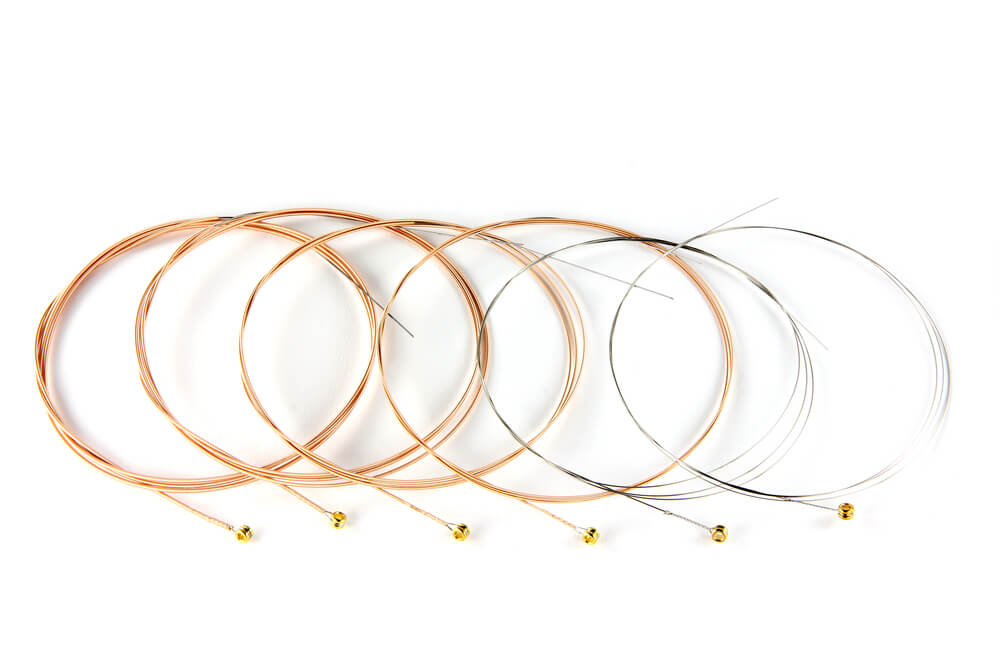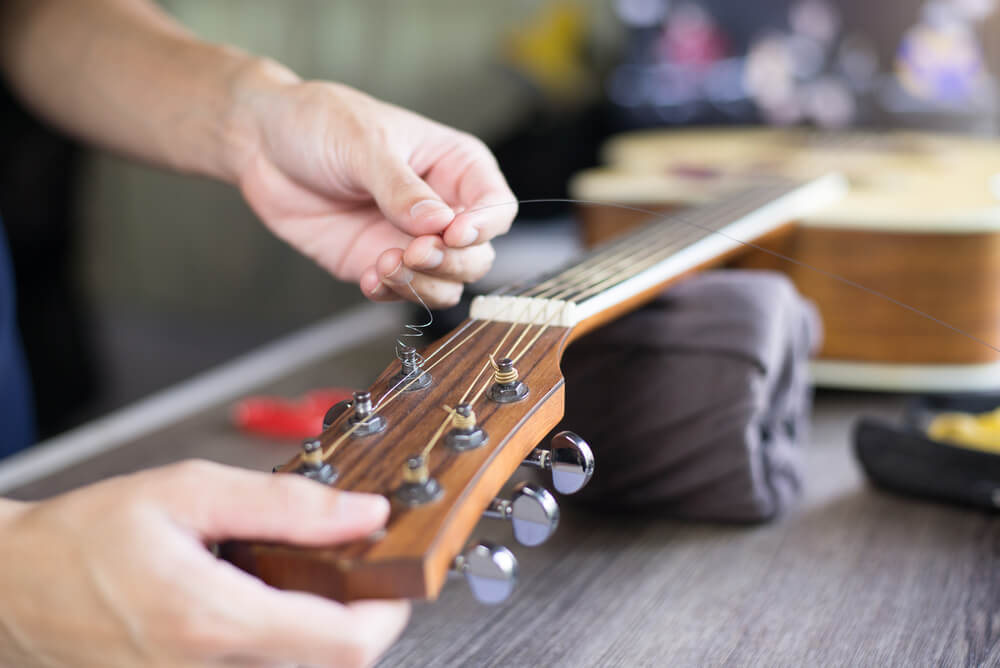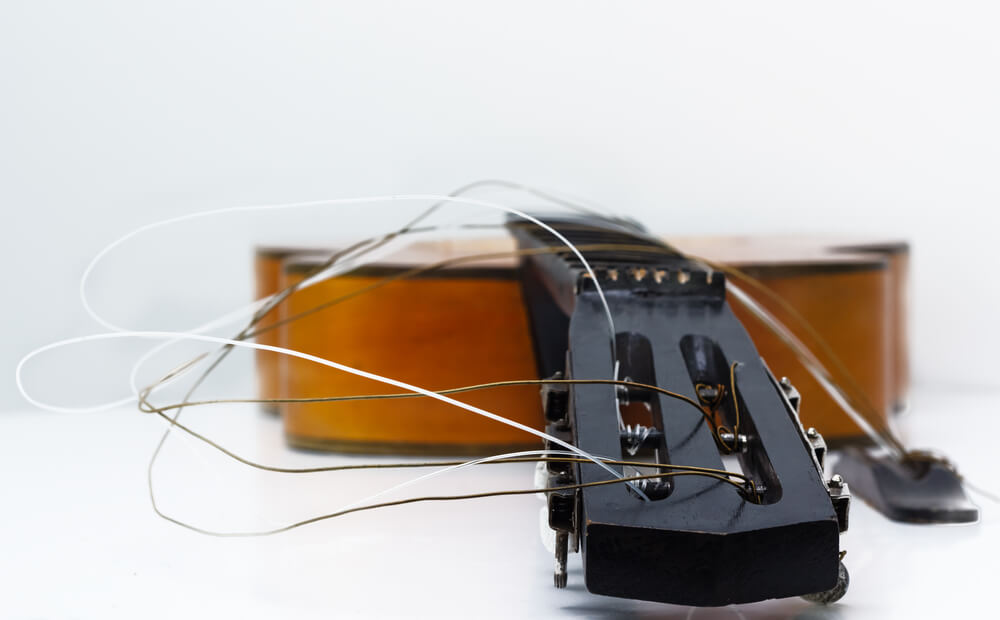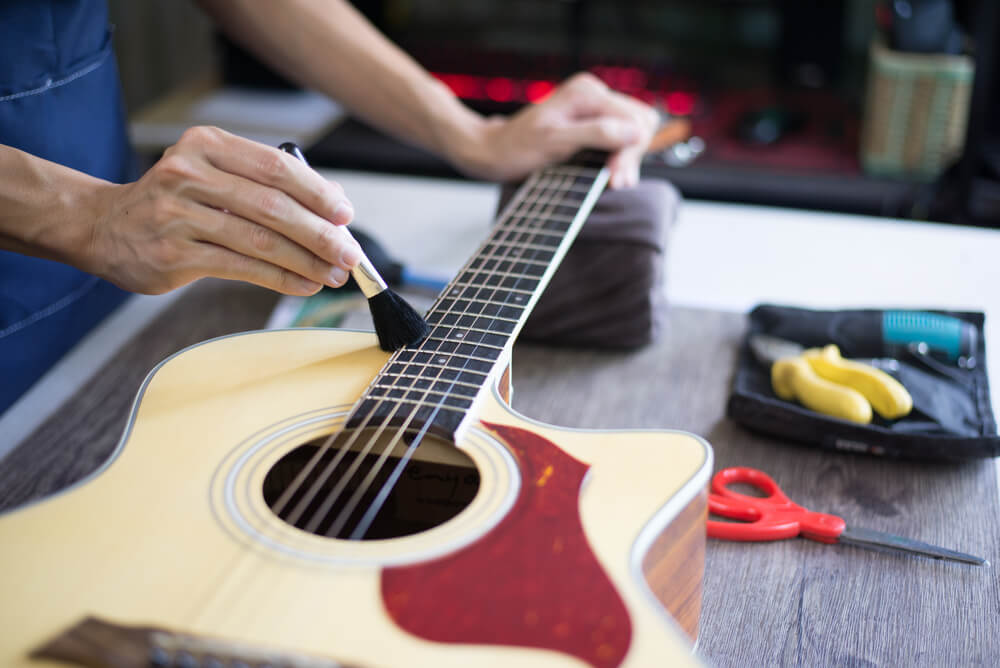As a guitarist, I know that the strings on my acoustic guitar are crucial to the sound I produce and the overall playing experience.
However, one question that often arises is how often to change acoustic guitar strings. The answer to this question is not as straightforward as one might think, with many factors influencing the decision.
It often depends on factors such as the type of strings, personal preferences, and how often the guitar is played.
Understanding the nuances of guitar strings and when to change them can significantly impact the overall sound quality and performance of your acoustic instrument.
By maintaining awareness of these factors and following recommended practices, I can keep my guitar in tip-top shape while ensuring that I always achieve the best possible sound.
Here, we’ll explore the various aspects of acoustic guitar strings and discuss how to identify the optimum time to change them.
Key Takeaways
- The frequency of changing guitar strings depends on several factors
- Proper maintenance and technique can prolong the life of your strings
- Selecting the right type of strings plays a role in overall sound and performance
How Often to Change Acoustic Guitar Strings
When it comes to guitar strings, there are several factors to consider, such as the type of guitar, string materials, and personal preferences.
In this section, I will discuss the differences between acoustic, electric, and nylon strings, along with coated and uncoated strings. I will also touch on string gauges, styles, and how different brands can affect the sound.
First, let’s talk about the differences between acoustic and electric guitar strings. Acoustic guitar strings are made of steel and produce a bright, crisp sound.
Electric guitar strings, on the other hand, are also made of steel but have a few variations in their composition, often including nickel or other metals.
This results in a less bright sound compared to acoustic strings. Nylon strings are commonly used on classical guitars, offering a softer, mellower tone than steel strings.
Now, let’s discuss coated and uncoated strings. Coated strings have a thin layer of protection, often made of materials like Teflon, which helps them resist dirt and moisture, prolonging their lifespan.
This can affect the sound, giving the strings a warmer and less bright tone. If you prefer a lot of brightness in your guitar’s sound, uncoated strings might be the better choice.
Keep in mind that uncoated strings will require more frequent changing as they are more susceptible to wear and tear.
The gauge, or size, of your guitar strings plays a significant role in how they feel and sound. String gauges come in different sizes, usually referred to as light, medium, and heavy.
Lighter gauges are easier to play, as they require less finger pressure, but can also produce less volume and sustain. Heavier gauges require more finger pressure to play but tend to have a richer tone and increased sustain.
Personal preference and playing style will be major factors in determining your ideal string gauge.
String materials and construction, like roundwound or flatwound strings, can also contribute to the sound and feel of your guitar.
Roundwound strings are more common and have a textured surface, providing a brighter sound and more sustain. Flatwound strings have a smoother surface, resulting in a warmer, less bright sound.
The choice between roundwound and flatwound strings will come down to tonal preference and playing style.
Finally, it’s essential to try different brands of guitar strings, as each brand may use unique materials and designs. This can result in different tonal qualities and playability, even when comparing strings of the same gauge and type.
Exploring various brands can help you find the perfect string choice for your personal preference and desired sound.
Armed with this knowledge, you can now make better-informed decisions when choosing and maintaining acoustic guitar strings. Finding the right combination of factors will lead to a more enjoyable and personalized playing experience.
When To Change Your Guitar Strings
As a guitarist, I understand the importance of keeping my acoustic guitar in the best possible condition. One essential aspect of this involves knowing when to change the guitar strings.
In this section, I will discuss the factors to consider when determining how often to change guitar strings and how to identify when it’s time for a replacement.
Firstly, it’s essential to recognize that every guitarist’s playing habits will impact the longevity of their guitar strings differently. I have noticed that the more frequently and aggressively I play, the quicker my strings seem to wear out.
For someone like me who plays daily, I usually change my strings every two to three months. However, if you play less frequently, you may only need to replace your strings every six months or even once a year.
Keep track of your playing habits to understand what schedule works best for you.
The look and feel of your guitar strings can also be a helpful indicator of when it’s time for a change. If you notice your strings becoming discolored, rusted, or corroded, it’s likely time to replace them.
Additionally, pay attention to how your strings feel beneath your fingertips. If they start to feel rough, dirty, or lose their smooth finish, this can signal that they may be reaching the end of their lifespan.
Tuning issues and the inability to stay in tune are also signs that your strings may need replacement.
If you find yourself constantly battling tuning issues or your guitar won’t hold its tune as well as it used to, it could be an indication that your strings have lost their elasticity and need to be changed.
Lastly, the sound of your guitar should be considered when determining how often to change your strings. Over time, your strings may lose their brightness and have a duller, muffled tone.
As a guitarist, you should aim for the optimal sound quality from your instrument. If the strings’ sound starts to degrade, it’s a clear sign that it’s time to replace them.
Keep an eye on your playing habits, the condition of your strings, and the sound quality of your guitar to determine how often to change your strings.
Factors Affecting the Lifetime of Guitar Strings
As a guitarist, keeping our instrument sounding fresh and in good condition relies primarily on the care and maintenance of its strings.
There are various factors that can affect the lifetime of guitar strings, such as the environment, playing habits, and how well we take care of them.
One of the main factors affecting string life is the natural oil and sweat from our skin. As we play, our fingers transfer dirt, oil, and grime onto the strings, causing them to lose their brightness and sustain.
This buildup of dirt and oil can also lead to corrosion and rust, which can cause strings to break more easily. To minimize this issue, I suggest cleaning the strings after each playing session with a soft cloth or specialized string cleaner.
Another major factor that impacts string life is humidity and moisture. Exposure to high levels of humidity can cause strings to tarnish and corrode over time, while low humidity levels can cause strings to become brittle and more prone to breakage.
It’s important for guitarists to maintain a stable indoor environment for their instruments, as fluctuating humidity levels can cause intonation issues and affect sound quality.
Next, regular tension and wear and tear from playing can cause strings to become dull and lose their vibrancy. Bending, strumming, and playing with an aggressive technique can cause strings to lose their resonance and occasionally form kinks, affecting their stability.
As guitarists, we can delay the effects of wear and tear by ensuring that we handle our instruments with adequate care and by avoiding applying excessive pressure on the fretboard when playing.
A more obvious factor is the frequency of playing. Gigging musicians or those who play for several hours a day tend to experience more wear on their strings, thus requiring more frequent string changes.
Also, playing in smoky clubs or other environments where the strings are exposed to various contaminants can shorten their lifespan.
Lastly, proper maintenance and care of the strings are crucial to prolonging their life.
Regularly cleaning the fretboard along with the strings and using a quality string conditioner can help prevent the buildup of dead skin, dirt, and debris, resulting in a brighter tone and longer string life.
In conclusion, keeping track of these factors and adopting appropriate measures to mitigate their effects can significantly impact the lifetime of guitar strings.
As guitarists, taking proper care of our instrument and its strings can ensure we always enjoy the best possible sound and playing experience.
How to Properly Change Guitar Strings
When I change my acoustic guitar strings, I usually follow a simple and efficient process to ensure that my guitar is properly restrung and in tune.
This not only enhances the sound quality but also prolongs the life of my fresh set of strings.
I start by loosening the existing strings using a string winder, which makes the process much faster and easier. After loosening all the strings, I carefully remove them from the tuning pegs and bridge pins. It’s essential to discard old or rusty strings thoughtfully to avoid any injuries.
Next, I clean the fretboard and bridge using a soft cloth or a specialized cleaner. This step is vital as it removes accumulated dirt and sweat, providing a fresh surface for the new strings. Once the guitar is clean, I’m ready to install the new strings.
I thread each string through the bridge pinhole, making sure the ball end is securely in place. Then, I pull the string tight and guide it through the corresponding tuning peg.
Before I start winding, I use a tuner to ensure the string is aligned correctly. Using a string winder, I carefully wind the string around the peg, maintaining a neat and tidy coil.
I repeat this process for each string, making sure to proceed in the correct order.
After all the strings are installed, I gently stretch each string by pulling it upwards and retuning them using a tuner. Retuning is crucial to establish the proper tension and pitch stability.
This step might need to be repeated until each string holds its tuning.
As a pro guitarist, it’s essential to know how to properly change guitar strings and maintain your instrument. Doing so not only improves the tone and playability but also helps you grow as a musician.
Maintenance Tips for Prolonging String Life
As a guitar player, I have found that taking good care of my strings helps them to last longer and ensures the best performance during practice and gigs.
Here are some tips I’ve learned to prolong the life of my acoustic guitar strings.
Firstly, keeping the strings clean and free of dirt, sweat, and grime is crucial for their longevity. After each playing session, I make sure to wipe down my strings using a clean, dry, soft cloth or rag.
This removes any oils and moisture that may have accumulated from regular playing. Using a dedicated string conditioner or light oil can also help to reduce string corrosion and keep the fretboard clean.
Another essential aspect of string care is proper stretching and adjustment. I often gently tug on my guitar strings to help them adjust to changes in tension, tuning, and overall playability.
This helps to maintain the strings’ overall pitch stability and prolongs their life.
Choosing the right type of strings can also make a difference in their lifespan. Coated strings can provide an extra layer of protection against rust and corrosion, making them an excellent choice for players who tend to sweat a lot.
Further, coated strings can reduce the amount of dirt and grime that can accumulate on the fretboard.
While it’s essential to keep the strings themselves in good condition, it’s also important to look after the entire instrument, including the fretboard and guitar body.
Regularly cleaning the fretboard with a damp cloth and a small amount of guitar polish will help remove dirt and oils that can settle into the wood.
This not only keeps the instrument looking good but also prevents the wood from becoming damaged by moisture, which can ultimately affect the overall sound and playability of the guitar.
Of course, proper storage and handling of the instrument are equally important. I always make sure to store my guitar in a cool, dry place, away from any sources of direct sunlight or heat.
This helps to prevent warping or other damage that may occur due to excessive moisture or extreme temperature fluctuations.
By following these maintenance tips, I have significantly prolonged the life of my acoustic guitar strings, keeping them sounding fresh and crisp for an extended period.
Remember, regular care and attention to detail will go a long way in preserving not only your strings but also your beloved instrument.
Choosing the Right Strings for You
When it comes to selecting the perfect set of acoustic guitar strings, it’s essential to consider various factors like string gauge, materials, and personal preferences in tone and feel.
In my experience, choosing the right strings is a crucial first step toward achieving the desired sound and playability on an acoustic guitar.
I believe it’s important to understand the difference between various string types, such as nylon and steel strings. Nylon strings offer a mellow, soft sound and are typically used on classical guitars.
On the other hand, steel strings are more commonly found on modern acoustic guitars and deliver a brighter, more resonant sound.
Another critical aspect of guitar strings to consider is whether to choose coated or uncoated strings. Uncoated strings usually produce a more vibrant sound due to the absence of a protective coating.
Nevertheless, they may not last as long and can be susceptible to corrosion. Coated strings, on the other hand, have a thin coating that helps prevent rust and extends string life.
While they may lose some of their initial brightness, many players find the trade-off in durability to be worth it.
When it comes to string gauge or the thickness of each string, it’s essential to find the right balance between tone and playability.
Lighter gauges, such as .010-.047, tend to be easier on the fingers and allow for easy bending but may not offer the same sustain and tonal depth that heavier gauges provide.
Heavier gauges, like .013-.056, require more finger strength but offer greater volume and a fuller, richer tone. Ultimately, the optimal gauge is a matter of personal preference.
With a wide variety of brands and styles available, it can be daunting to find the perfect set of strings.
In my experience, experimentation is key. Each brand has its unique characteristics, and trying different types and gauges can help identify the ideal match for your needs and tonal preferences.
Choosing the right acoustic guitar strings is a crucial part of crafting your ideal sound and playing experience. Considering factors such as string type, gauge, and coating can find the perfect set tailored to your preferences and playing style.
Frequently Asked Questions
How can I tell if my guitar strings need to be replaced?
I usually look for signs like loss of tone, a duller sound, and difficulty in tuning my guitar. A visual inspection can also help; if the strings are noticeably dirty, rusty, or have visible wear and tear, it’s time to change them.
How long should I wait before changing my acoustic guitar strings?
I generally change my acoustic guitar strings every 3 to 4 months, depending on how often I play and the sweat and oils from my fingers. Some players might need to change them more frequently, depending on their playing habits and personal preferences.
Do professional musicians change their guitar strings more frequently?
Yes, professional musicians tend to change their guitar strings more frequently, as their performances and recording sessions require the best possible sound quality.
Some professionals change their strings before every gig, while others may do it every few days, depending on how much they play.
What are some signs of worn-out acoustic guitar strings?
Worn-out acoustic guitar strings may exhibit a duller sound, reduced sustain, and trouble staying in tune. Visibly dirty, rusty, or kinked strings also indicate that it’s time for a string change.
Also, if the strings feel rough and uncomfortable to play, it’s a sign that they are worn out and need replacing.
Is there a difference in changing bass strings compared to acoustic guitar strings?
Yes, there is a difference in changing bass strings compared to acoustic guitar strings. Bass strings are generally thicker, and the tuning machines or headstock design may be different.
Regardless, the basic principles are the same: remove the old strings, clean the instrument, and install the new strings properly.
What factors can affect the lifespan of acoustic guitar strings?
Factors that can affect the lifespan of my acoustic guitar strings include frequency of playing, humidity, sweat, and oils from my fingers.
Storing the guitar with a clean, dry cloth and in a case, as well as washing my hands before playing, can help prolong the lifespan of the strings. Using a string cleaner and lubricant can help extend their life.








